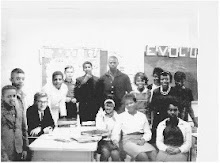ReQuest (Reciprocal Questioning) Procedure: Roots in Reciprocity, Focused Mental Modeling & Mirror Neurons
Reciprocity - or give & take between teacher & students - is an often overlooked cornerstone of effective cognitive modeling, or apprenticeship teaching. Mental Modeling is being found to be grounded in the very anatomy of the brain. It is called Mirror Neurons in humans, it appears to allow a movement, gesture or articulated thought to be copied and replicated in the brain from a model. In this way it becomes a reflection that through extension becomes a new lesson. It has been said that Mirror Neurons not only allows a movement or recognition of a novel cognitive act to be copied from a model but the neurons face off at one another allowing an image to be more easily extrapolated to various stages and to infinity. Ironically, the Request Procedure (see example ahead) seems to have provided a proof of this principle about 40 years ahead of the discovery of Mirror Neurons (See blogg entry on Mirror neurons for more on this fascinating development). Generally, instructional reciprocity means providing opportunities for students to assertively, though non-aggressively "poke-back" and both model and influence the direction of a lesson, or dialogue. Importantly, it does not cause the teacher to relinquish responsibility or control over lesson objectives (Manzo & Manzo, 1990a). Reciprocity is a seamless form of diagnostic-teaching that permits teacher and student to home-in on a “zone of proximal development” (Vygotsky, 1978), or the region of greatest receptivity to instruction. Reciprocity also provides a subtle means for students to interject needed breaks, repetitions, and clarifications in instructional conversations . One of the side benefits is that teachers often learns nearly as much about teaching the students before her as do students about learning from each the teacher and each other. See the ReQuest Procedure below for a essential elements example of the use of reciprocity and cognitive modeling in strategy teaching for comprehension improvement.
_____________________________________________________________
Figure
ReQuest Procedure, in Brief
This procedure was designed to teach students how to set their own purpose for reading almost any selection through a self-directed inquiry, as opposed to the next best form of “frontloading,” whereby the teacher gives students a reason/purpose for which to read.
Steps in the ReQuest Procedure
Step 1 Both teacher and students read the title and first sentence only of the first paragraph of a selection, and look at any pictures or graphics that are part of the introduction.
Step 2 The teacher tells students to ask as many questions as they wish about the first sentence, the title and/or pictures or graphics. The teacher turns his or her copy of the selection face down, but students may continue to look at their copies. Students are told that they should ask the kinds of questions that they think a teacher might ask. (This permits students to ask “ego-protective” questions since they need not reveal whether they know the answers to the questions they ask.)
Step 3 When all student questions have been fully and politely answered, the teacher turns his or her book face up while students are instructed to turn theirs face down. The teacher then asks as many additional questions (about the title, first sentence, and illustrations) as seems appropriate to bring about a sense of focus and purpose for reading the selection. The last of these questions (over the first sentence, and then in subsequent question sets on following sentences) should simply be, “What do you suppose the remainder of this selection will be about?”
Step 4 The next sentences are handled in the same way, with the student again leading off the questioning, followed by teacher questioning, and concluding with the question, “What do you suppose the remainder of this selection will be about?”. The number of sentences covered should be based on teacher judgment: the ReQuest activity should conclude as soon as a plausible purpose for reading has been evolved, but should not last more than about ten minutes.
Step 5 At the conclusion of the ReQuest activity, the student is encouraged to continue reading the selection silently for the purpose that has been developed.
Step 6 Following silent reading, the teacher should first ask the evaluative question: “Did we read for the right purpose?” *
*This final question is asked before the actual question for which a purpose was set. The reasons for this are worth noting: First, it helps to overcome what has been called “confirmation bias” (Garrison & Hoskisson, 1989), or the tendency to conclude only what has been predicted. Second, it helps to keep the focus of instruction on the development of effective strategies for independent reading and learning more so than merely on comprehending a given selection. Third, it further develops the important metacognitive habit of monitoring one’s own comprehension and use of strategies while reading. Manzo, Manzo, Albee, (2004).
_____________________________________________________________
See more: Content Area Literacy: A Framework for Reading-Based Instruction (5th edition)
Wiley (2009)and: Reading/Learning Assessment for Diagnostic-Prescriptive Teaching, 2nd edition (w. U. Manzo and Julie Albee) Belmont: California, Thomson/Wadsworth Publishers (2004).
Subscribe to:
Post Comments (Atom)

No comments:
Post a Comment